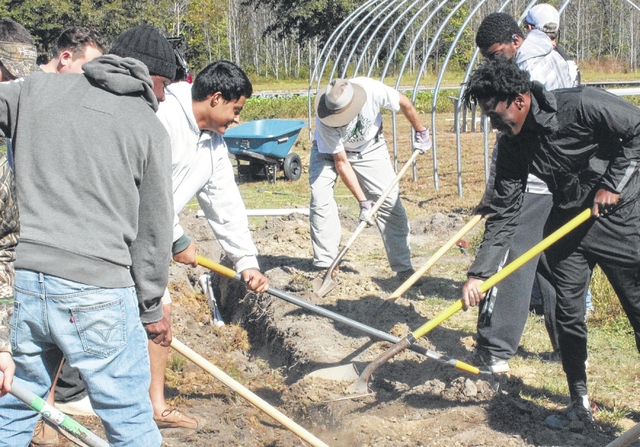LAURINBURG —As a nonprofit works to turn a former Wagram prison into a sustainable farm, the group is a building a greenhouse here this week to provide examples what the final project may yield.
About a dozen young people along with GrowingChange founder Noran Sanford, worked on Saturday to build a “green house” to grow hydroponic greens at the Community Garden behind First Presbyterian Church. They were joined by students from St. Andrews University.
The Laurinburg greenhouse will serve as an educational site for GrowingChange, according to Sanford.
“As we transform the closed Wagram prison into a sustainable farm and educational center, this will be a Laurinburg site to demonstrate some of our work,” Sanford said.
GrowingChange works to plans to use the abandoned Scotland Correctional Center to help at-risk youth by combining cognitive behavioral therapy, youth entrepreneurial development and service learning opportunities as participants grow food for needy families.
“Growing Change has helped me be a better person,” said Ezekiel Jones, an 18-year-old senior at Hoke High School.
Once completed, the Wagram site will also serve as a educational and recreational facility. The organization would like to flip prisons in 25 communities by the year 2025.
The project has been funded by a grant provided by North Carolina A&T. Sanford predicts the project in total will cost $11,000.
“We are blessed to have the cooperation with North Carolina A&T State University supporting this with a small grant, USDA Strike Force which made the high tunnel possible and the generous support of Lumber River Native Plants owned by Jeff Woodlock — his expertise in setting up the high tunnel was invaluable,” Sanford said.
The greenhouse, also called a high tunnel, will use hydroponic system allows for crops to be grown without being planted in that ground, a technique said to limit the change for contamination. High tunnels are an integral part of local food production systems in many parts of the United States. They aid fruit and vegetable crop production by extending the cropping season, providing protection from the elements.
The crops grown in the greenhouse will also provide another tie for St. Andrews to the community. The university plans to use some of the greens — kale, Swiss shard, spinach and lettuce — grown in its cafeteria.
“Specifically, the young greens that will be grown in the hydroponic system will go to the food service at St. Andrews to create a micro food system,” Sanford said.
This will also for SAU students to be more involved in the community, according to Sanford.
“We are promoting healthy food and growing crops in our own community,” said Devon Washington, a St. Andrews senior.
The organization also plans to give some of the food they grow to those in need.
The greenhouse should be completed by the end of the week.

